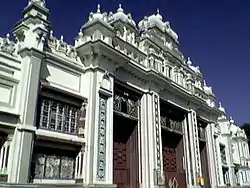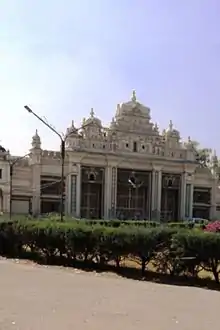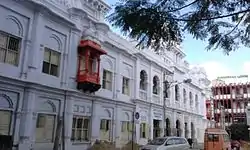Jaganmohan Palace
Jaganmohan Palace is a palace in the city of Mysore, India. Its construction was completed in 1861 and was initially used by the Wodeyars, kings of Mysore as their home (when the present Mysore Palace (Amba Vilas Palace) was under construction after the previous palace burned down). It is now used as an art gallery and a function hall. The palace is one of the seven palaces of the royal city of Mysore.

.jpg.webp)
History
The Jaganmohan Palace was constructed in 1861 by the king Krishnaraja Wodeyar III as an alternate retreat for the royal family.[1] The Mysore Palace, which was the original home of the royal family was burnt down in a fire and the construction of a new palace in its place was started in 1897. Till the new palace was completed in 1912, the Jaganmohan Palace was used by the royals as their home.[2] In 1902, the king Rajarshi Nalvadi Krishnaraja Wodeyar was installed to the Mysore throne, in a ceremony that took place in a pavilion inside the Jaganmohan Palace. This ceremony was attended by Lord Curzon, the then Viceroy and Governor General of India.[2] The palace was used for his daily durbar by the king and also the special Dasara durbar during the dasara period. In 1915, the palace was converted into an art gallery, which was later renamed in 1955 in the name of HH Jayachamarajendra Wodeyar, as the Sri Jayachamarajendra Art Gallery .[3] The early convocations of the Mysore University were also held in this palace. The first session of the Legislative Council of the Mysore state was held here in July 1907.[4] The Legislative Council was then called as the Representative Council and was presided over by the Diwan (Prime Minister of the state). HH Jayachamarajendra Wodeyar converted the palace into a trust and opened it for public viewing.
Architecture

The palace is built in traditional Hindu style and has three stories. In 1900, an external facade with a hall behind it was added to the palace. This facade has three entrances and the entablature has religious motifs and miniature temples crafted on it.[5] This mural is the earliest known picture of the Mysore Dasara and has been painted using vegetable dyes. A family tree of the Wodeyars tracing the lineage of the royal family is also painted on a wall.[5] Two wooden displaying Dashavatara, the ten incarnations of the Hindu God, Vishnu is also present in the palace.
Art Gallery
The art gallery contains one of the largest collections of artifacts in South India.[6] Most of these artefacts are paintings, prominent among which are those by Raja Ravi Varma, some of which demonstrate scenes from the Hindu epics, Ramayana and Mahabharatha. The collection of paintings in the gallery exceed 2000 in number and these belong to different Indian styles of painting like Mysore, Mughal and Shantiniketan.[5] 16 paintings of Raja Ravi Varma were donated to the gallery by Jayachamarajendra Wodeyar.[5] Another important painting present here is the Lady with the lamp which was painted by the artist Haldenkar and is placed in a dark room where it is the only exhibit. This is to give an illusion that the glow of the lamp is illuminating the face of the woman.[5] Some other painters whose works are exhibited here include Nikolai Roerich, Svetoslav Roerich and Rabindranath Tagore and Abanindranath Tagore. There are beautiful paintings by the Ukil brothers -Sharada Ukil, Ranada Ukil and Barada Ukil.[7] Another collection of paintings by a British Army Officer named Col. Scot on the wars between Tipu Sultan and the British army are said to be the only visual representation of the wars.[5]
Other exhibits here include weapons of war, musical instruments, sculptures, brassware, antique coins, and currencies.[6] Some other unique artefacts exhibited here is a French clock which has a mechanism in which a parade of miniature soldiers is displayed every hour; beating drums mark the seconds and a bugle marks the minute.[8] Paintings made on a grain of rice which can be viewed only through a magnifier are also displayed here.
Restoration

A new hall was built in 2003 because there was insufficient space available to exhibit all the paintings.[9] The original paintings of Raja Ravi Varma which are over 100 years old are being restored by the Regional Conservation Laboratory (RCL). Syrendri (which had a hole in the canvas), Victory of Meganath and Malabar Lady were some of the paintings of Ravi Varma to be restored.[10] Unscientific stretching of the canvas on which the paintings were drawn was one of the major problems noticed including unprotected exposure to dust, heat and light. Even the murals on the walls had been damaged because of water seepage and these were also restored by RCL.
Despite what is mentioned here regarding the restoration of these paintings, recent visits to the Jaganmohan Palace suggest gross neglect. These priceless paintings are ill maintained and incompetently restored. For example, in the painting of Ravana slaying, Jatayu by Raja Ravi Varma the colors used to restore the painting are different from the ones used in the original painting. The painting is also torn and ridden with holes at the bottom. One can only understand the tragic plight of this extremely powerful painting when one visits the palace. Painting the walls of this room has also resulted in damage to the paintings, with the paint from the walls dripping on the uncovered paintings. These paintings which are already in very bad condition are further affected by the abysmally poor lighting and humidity conditions. The painting of the lady holding the lamp by Haldenkar is also poorly exhibited. The windows are covered by a moldy cloth to supposedly give the effect of "shade" which only ends up ruining the effect due to the poor lighting in the first place. This palace and its contents especially the Ravi Verma paintings are in dire need of attention and very poorly managed.
Auditorium
Jaganmohan palace also has an auditorium which is used for traditional dance performances,[11] music festivals[12] and other cultural programs mainly during the period of dasara.
See also
Notes
| Wikimedia Commons has media related to Jaganmohan Palace. |
- "Jaganmohan Palace".
- Priyanka Haldipur. "Of Monumental value". Online Edition of The Deccan Herald, dated 2005-04-19. Archived from the original on 15 October 2007. Retrieved 20 September 2007.
- "Jaganmohana Palace". Online webpage of the Mysore district. Archived from the original on 13 September 2007. Retrieved 20 September 2007.
- "Upper House turns 100". Online Edition of The Deccan Herald, dated 2007-07-06. Archived from the original on 6 April 2012. Retrieved 20 September 2007.
- R Krishna Kumar (11 October 2004). "Priceless souvenirs of Mysore Dasara". Online Edition of The Hindu, dated 2004-10-11. Chennai, India. Retrieved 20 September 2007.
- R Krishna Kumar (14 February 2004). "The rare and the regal". Online Edition of The Hindu, dated 2004-02-14. Chennai, India. Retrieved 20 September 2007.
- Ravi Sharma. "Tourism delights". Online Edition of The Frontline, Volume 22 - Issue 21, Oct. 08 - 21, 2005. Archived from the original on 14 October 2007. Retrieved 20 September 2007.
- Kuldip Dhiman. "Pomp and show of a royal age recreated". Online Edition of The Tribune, 1998-11-01. Retrieved 20 September 2007.
- "Sri Jayachamarajendra Art Gallery set to get a facelift". Online Edition of The Hindu, dated 2003-03-20. Chennai, India. Archived from the original on 4 December 2005. Retrieved 20 September 2007.
- "Restoration: Half kilo of dust stupefies Ravi Varma's work". Online Edition of The Deccan Herald, dated 2005-06-03. Retrieved 20 September 2007.
- "A music and dance feast". Online Edition of The Hindu, dated 2005-10-14. Chennai, India. 14 October 2005. Retrieved 20 September 2007.
- "Notes of nostalgia". Online Edition of The Hindu, dated 2005-12-23. Retrieved 20 September 2007.